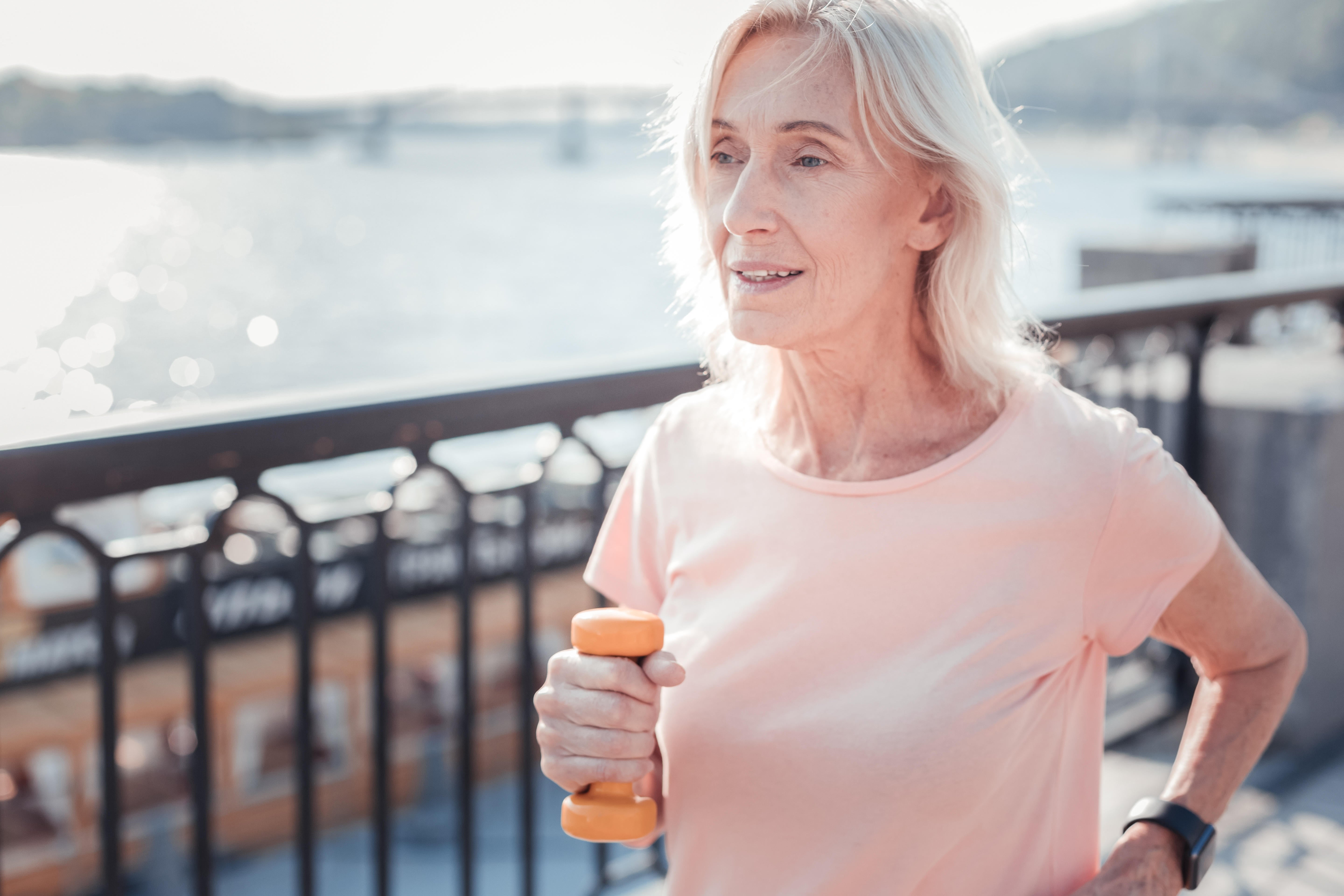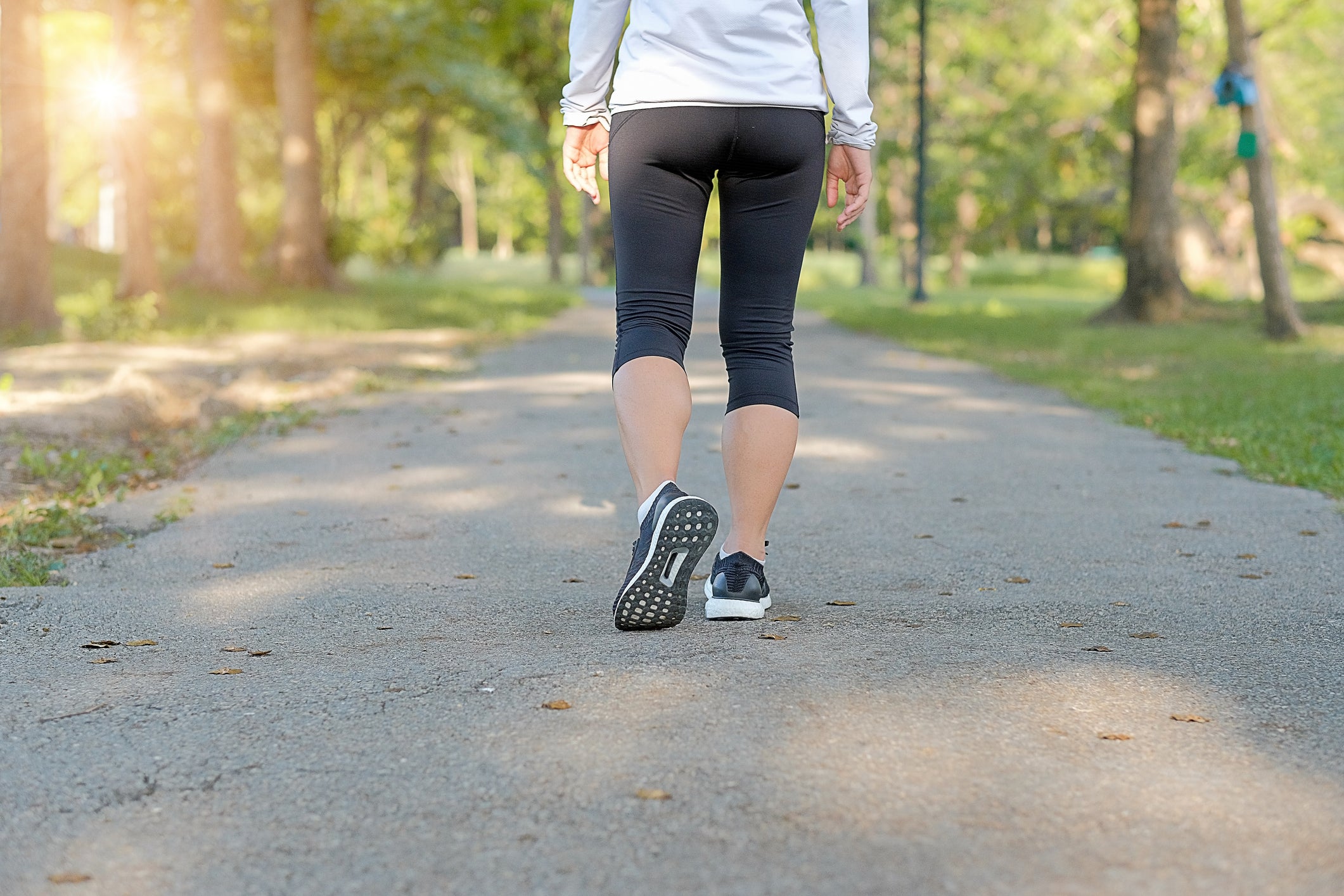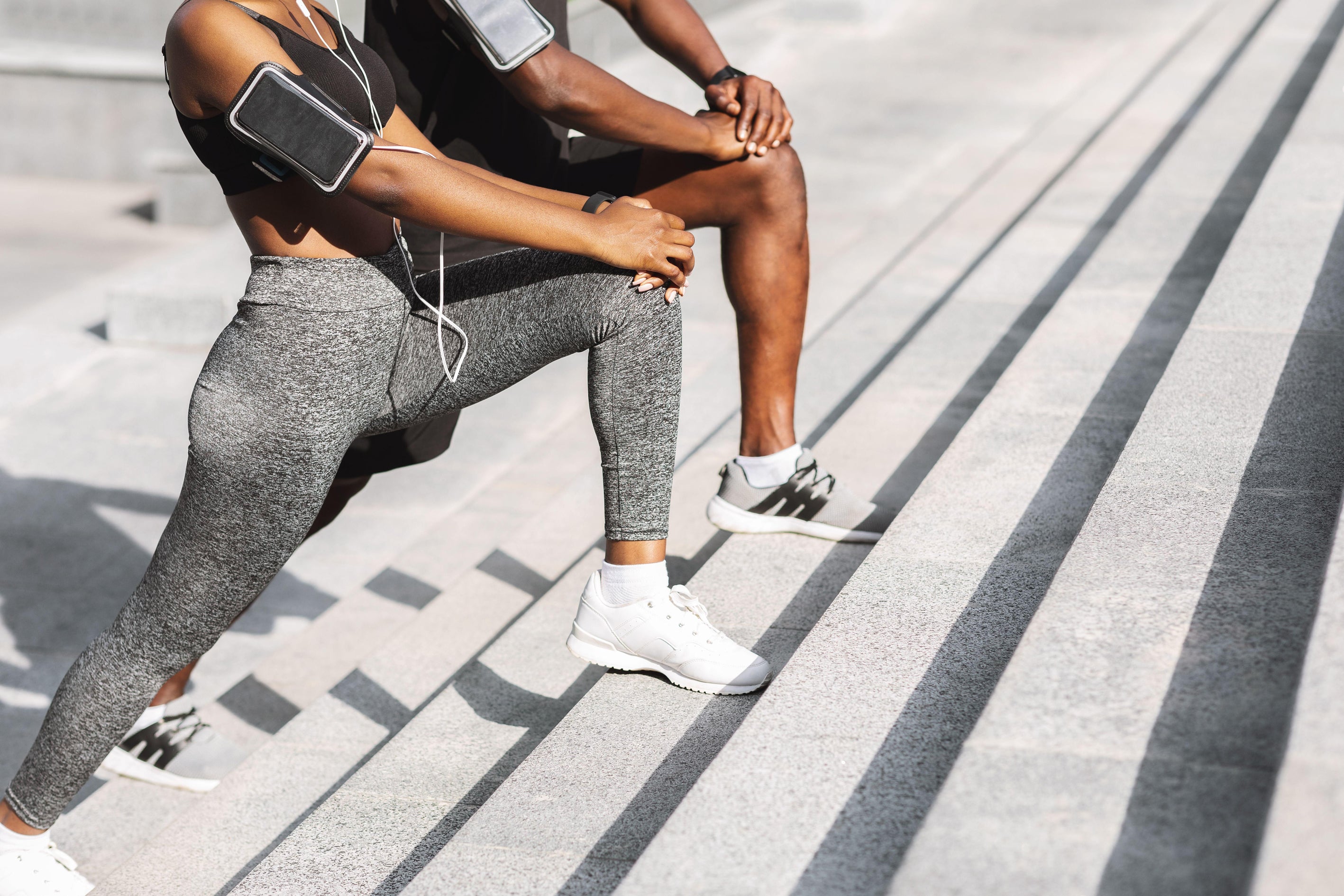Fitness
Think Your Way Out of Negativity: 6 Thought Exercises That Can Save Your Mental Health

Have you ever felt trapped in a cycle of negative thinking you can’t seem to kick? It’s easy to fall into these thoughts, especially when you’re feeling stressed or sleep deprived. In honor of Mental Illness Awareness Week, let’s talk about one of the simplest ways to boost your mental health: Thought exercises. They’re a simple and no-cost way to break those negative thinking patterns and change how you perceive things.
They can also help us make our subconscious thoughts go in more productive, helpful directions over time, and they’ll eventually cut out those negative thinking patterns entirely. Regain control over your mental health with the best thought exercises you can start right now.
Also learn which foods to eat for a happiness boost and which color to paint your bedroom for the best mental health.
What is a thought exercise?
Thought exercises are new ways to think about a given circumstance or experience that can help us get out of a stuck or unhelpful way of thinking. While some thought exercises have been studied extensively by psychological researchers, others are offered by psychologists and clinical mental health counselors because they’ve been helpful anecdotally for specific types of patients. Thought exercises may be suggested by your therapist, whether they are online or in-person.
It’s important to keep in mind that there isn’t a one-size-fits-all thought exercise. Feel free to try one of them for a few weeks and see if you like the way they impact your mental health and feelings of well-being. If not, you can try a different one. Thought exercises are meant to be a method of seeing the world differently, not a medical treatment.
What are the benefits of thought exercises for mental health?
Reframing thoughts is one of the building blocks of cognitive behavioral therapy, which has been found effective in many studies.
- A go-to thought exercise can help one maintain calm during a stressful moment and continue functioning, staving off a more severe reaction like an anxiety attack.
- Thought exercises can reduce the duration and intensity of anxiety symptoms even when not combined with traditional therapy.
- When paired with a mental health app, thought exercises can provide a log of one’s growth and changes in mental health.
- Thought exercises can make us more mindful of what triggers our anxiety, allowing us to make life modifications that help us to experience anxiety less often.
6 thought exercises that will boost your mental health
Next time you’re feeling stressed out, try one of these methods to help combat overwhelming feelings.
The self-observation exercise
Many spiritual traditions include some kind of self-observation or mindfulness exercise, but it is helpful in a completely nonspiritual context as well. When you begin to experience the symptoms you associate with anxiety, you can use this exercise to get curious and learn more about what you’re going through. Here’s how to do it:
1. When you’re feeling anxious and have the opportunity to take a couple minutes to yourself, do so. Get away from others so you won’t be interrupted, even if it’s just a few minutes.
2. Start noting the way that every element of your body feels. Are you feeling the anxiety in your shoulders, neck, stomach or head? Are you experiencing other symptoms, like fatigue or a headache? Don’t judge the feelings, just note them, like you were observing a scientific experiment and needed to catch everything.
3. Then turn your self-observation to your thoughts. What are the specific stressors cycling through your mind? Try to catalog them, rather than letting them overwhelm you. When you’ve noticed one, let it go, recognizing that you’ve “heard” it.
4. If you can get to a place of fully focusing on bodily and mental sensations, you may find yourself able to calm down, doing things like releasing the muscles you’ve discovered are tense or letting thoughts go instead of holding onto them intensely. This may take a few tries.
The act of self-observation can be a way to take your mind off the anxiety and come back to your body. When we’re in fight-or-flight mode, the anxiety gets us to safety, but if we are physically safe, this can be a way to evaluate our body and find our baseline again.

Self-observation exercises can help you stay grounded in the present.
Keep a thought record
One of the ways that people better understand their anxiety symptoms is by recording their thoughts. This can be done in a traditional paper journal, but there are other options, especially when it’s inconvenient to carry an extra notebook everywhere. The app Thought Diary is a simple interface, letting you write down your mood and any details about it. It also includes other thought exercises, such as practicing gratitude and analyzing a thought.
Reviewing your thought record occasionally can help you draw connections, including things like how sleep, exercise and nutrition impact your anxiety symptoms.
Interrupt anxious thinking
Anxious thinking responds best to being distracted by a different task. These techniques are more about what effectively distracts you and less about a technically “right” method.
- Try tensing and relaxing different muscles in your body, focusing on the muscle activity and seeing if it can help you stop thinking anxious thoughts.
- Breathing with an intentional count, like four counts in and four counts out.
- Putting on music, an audiobook or a radio show can interrupt anxious thoughts and bring your mind to bear on something else.
- Loudly saying that you’re done thinking this way or verbally speaking affirmations can help get out of one’s head and hear a positive voice more clearly.
- Choosing a soothing task that is also mentally engaging: word games on your phone, loading a dishwasher, doing a yoga flow or other set routine of stretching can all be effective anxiety interruptions.
- Counting backward slowly sometimes works to interrupt the flow of anxiety.
Use cognitive defusion exercises
Cognitive defusion exercises are all about getting an outside perspective on our thoughts, or strategies that help us detach and look more clearly at our thoughts. They are used frequently in CBT and other types of cognitive therapy.
- Use a silly voice: Some people find it helpful to detach from their thoughts by using a silly voice to say something like, “Oh, you think this is very concerning, do you?” or some other observation about the thought.
- Leaves on a stream: Some people use the visualization that their thoughts are floating down a river, coming to them and then going away, as a way to see the thoughts as separate from their core identity.
- Label your thoughts: Some people find it helpful to identify “that is an anxious thought” or “this is a fearful thought” as they have the thoughts, helping to take them out of being an assessment of reality and treating them as separate items which don’t have to be believed outright.
- “Thank you mind”: When our minds tell us a warning in the form of an anxious thought, we can offer gratitude to our mind for trying to help us and warn us.
Practice self-compassion
Anxiety sometimes presents as excessive worry that one isn’t good enough or has negative traits. These thoughts, when played on a loop, can be demoralizing and can make everyday activities miserable. A way to combat this negative self-talk is to practice self-compassion. While it may seem odd at first, trying to see your current situation the way you’d see it if a good friend was going through it can be a start. Give yourself the kind of comfort you’d give a friend, instead of the harsh critique you often give yourself.
Another self-compassion exercise is to find and focus on a photograph of yourself from childhood. Instead of directing your thoughts toward your adult self, direct them to that child. Recognize that your adult self deserves the same kind of comfort that a child deserves, as you are also still learning, albeit different things.
The worry tree
The worry tree is a tool developed for those who experience compulsive or continual worry to help them make a conscious decision between worrying or doing something else. It is a flowchart graphic that is customizable to the person, but essentially starts by questioning, “what exactly am I worried about?” then “Can I do something about it?” and “Can I do something about it right now?” The tree guides people to let worries go when nothing can be done, to make a clear plan if nothing can be done right now, and to go do something if there is something useful to be done about the worry right now. It can help avoid rumination, where we think the same anxiety-inducing thoughts over and over without relief.
The bottom line
Thought exercises can feel different from our typical ways of thinking, but if you remain curious, you may find your mind changing, experiencing more methods for how to think positively over time. If you find that thought exercises make your anxiety symptoms worse, you may have an ineffective thought exercise for yourself, or your anxiety might respond better to treatment from a psychiatrist or counselor. Talking with a mental health professional is a good idea to get better answers about your specific situation.
More mental health advice

Fitness
Hanging neck exercise: Bizarre workout trends among China's aging population – Times of India

Just when you think the internet can’t surprise you anymore, something wild pops up. Imagine strolling through a park in China and seeing a group of elderly folks—yes, seniors—literally hanging by their necks from tree branches or workout bars. No, this isn’t a scene from a sci-fi flick or some bizarre stunt show. It’s a real fitness trend sweeping through China’s older population, and it’s as strange as it sounds.
How did this even start?
The trend seems to have started in Shenyang, a city in northeastern China. A 57-year-old man came up with a DIY neck-hanging device to deal with his own nagging neck pain. He claims it worked wonders. Word spread, and before you know it, other seniors were giving it a shot—and posting about it online.These “neck hangers” say the exercise helps stretch out the spine, ease nerve pressure, and tackle chronic back and neck pain. Some even say it helps them sleep better. One woman swears it cured her spinal issues entirely and now she sways from a tree like it’s the most natural thing in the world.Watch the video:
Sounds cool… until it’s not
But here’s the kicker—doctors and health experts aren’t thrilled.The human neck isn’t exactly built to support the full weight of the body, especially when it’s swinging around. Medical professionals warn that this kind of stress on the cervical spine can lead to some serious problems: pinched nerves, permanent injuries, or worse.And sadly, this isn’t just theoretical. In May 2024, a 57-year-old man in Chongqing died while attempting the exercise. He used a chin strap at a public workout area but mistakenly placed the strap on his neck instead of under his chin. When he started swinging, the pressure was too much—and it ended in tragedy.
Not just neck hanging: other quirky fitness fads
The neck-hanging craze might be grabbing the spotlight, but it’s far from the only oddball exercise trend among China’s aging crowd. Here are a few more that might raise your eyebrows:Crocodile crawling – Picture this: groups of seniors crawling on all fours across the park, chanting together. They believe it strengthens the spine and boosts flexibility. It’s got a kind of military boot camp vibe—if that boot camp was run by your grandma.Tree bumping – Some folks are literally walking up to trees or poles and bumping their backs into them—repeatedly. The idea is to stimulate the spine and help with issues like cervical spondylosis.Head-butting trees – Yep, you read that right. Instead of bumping with their backs, some seniors go head-first, believing it builds endurance and mental strength.Groin striking – This one might make you wince. Practitioners use metal objects to strike their groins, claiming it boosts vitality and masculinity. Ouch.As bizarre as these sound, they all stem from the same motivation: a strong desire to stay healthy, active, and independent—even in old age.
So, why are seniors turning to these strange workouts?
It’s not just about staying in shape—it’s also cultural.Traditional Chinese medicine often leans toward holistic, non-drug remedies. Many seniors prefer these natural approaches over popping pills or undergoing surgery. Add in the rise of social media, where videos and testimonials can go viral in seconds, and you’ve got the perfect recipe for a fitness trend explosion.Plus, in a lot of cases, older adults may not have easy access to modern medical care or reliable health information. So when someone in the park swears that neck-hanging or tree-bumping helped them feel better, others are quick to follow.
Harmless hobby or hazard?
Look, staying active as you age is important. No one’s arguing that. But when workouts start involving neck-hanging and groin-hitting, maybe it’s time to hit pause and consult a professional.Doctors say there are safer, proven ways for seniors to stay fit—like walking, tai chi, yoga, or swimming. These might not go viral on TikTok, but they also won’t land you in the hospital.So, while it’s fascinating (and admittedly kind of entertaining) to see what’s trending in the parks of China, let’s not forget that fitness should help you live longer—not shorten your lifespan.Would you hang from a tree for your health? China’s elderly say yes. But maybe, just maybe, let’s leave this one to the professionals—or the daredevils.
Fitness
This Marion senior fitness class has flipped the script on exercise.
Skip to content
Fitness
How to exercise safely in the heat: Fitness experts share their top tips

Exercising outdoors provides benefits such as fresh air and vitamin D. However, as summer nears, safety precautions are essential.
Exercising in the heat can lead to dehydration and heat exhaustion, especially for beginners and older adults. Avoiding peak sun hours and seeking shade are advisable.
Listening to your body and taking breaks are crucial to prevent overheating and exhaustion.
To help you stay safe while staying active, we spoke with fitness experts who shared their top tips for exercising safely outdoors this summer.
Acclimatise

“A lot of people jump straight into workouts in the summer without acclimatising – this is a mistake,” says Michael Betts, personal trainer and director of TRAINFITNESS. “Our bodies generally need one to two weeks to adapt to exercising in the heat.
“Older adults need extra time for acclimatisation because ageing affects your body’s ability to regulate temperature. Your sweat response becomes less efficient, and your cardiovascular system may not adapt as quickly to heat stress.
“Start with shorter sessions that are less intense and gradually build up your tolerance.”
Apply sunscreen
“Sunscreen with SPF30 or higher should be applied 30 minutes before going outside,” advises Betts. “Reapply every two hours or more frequently if you’re sweating heavily.
“Don’t forget often-missed areas like the tops of your ears, feet and the back of your neck.”
Work out in the morning

“Early morning between 6am and 8am offers the coolest temperatures and lowest UV exposure,” says Betts. “Your core body temperature is naturally lower when you wake up, giving you an advantage for temperature regulation.”
He also recommends avoid exercising between 10am and 4pm if possible, as this is when temperatures peak and the UV rays are at their strongest.
“This window is particularly dangerous for older adults whose bodies take longer to recover from heat stress,” explains Betts. “If you must exercise during these hours, seek shade and reduce intensity significantly.”
Stay hydrated
“Exercising in the heat causes your body to sweat, which is a way of regulating your body temperature, helping your body to cool down, but without enough water your body could overheat or even experience heat stroke,” warns Sarah Campus, personal trainer and founder of LDN MUMS FITNESS.
“Staying hydrated supports mental sharpness, and supports body and muscular function, allowing for increased flexibility and mobility.
“Also, hydration is important for your heart as without enough water you could feel faint or dizzy.”
Be aware of signs of heat exhaustion and dehydration

“Dry mouth, dry lips, headache, dizziness, dark yellow urine, muscle cramps and a fast heartbeat are all warning signs to look out for,” says Campus.
Wear cool clothing
“Your skin’s ability to regulate temperature decreases with age, making proper clothing choices even more critical,” explains Betts. “Cotton holds sweat against your skin instead of wicking it away, which prevents your body from cooling effectively.
“Instead, opt for loose-fitting light coloured clothes which will reflect the heat and allow air to circulate around your body.
“Synthetic materials like polyester blends or merino wool work well for moisture management. These fabrics dry quickly and help sweat evaporate, which cools your skin. Some modern fabrics even have built-in UV protection.”
Wear a hat
“Hats with wide brims will protect your face, ears and neck from the sun while giving a bit of shade, helping keep your head cool,” says Betts. “Hats with mesh panels or ventilation holes will help prevent heat building up.
“A hat with a neck flap offers additional protection for this vulnerable area.”
Exercise in the shade

“Exercising in shaded areas or with frequent rest periods are smart choices,” says Betts. “Circuit training where you move between shaded stations works well.
“Body weight exercises under trees or covered pavilions let you strength train without direct sun exposure.”
Try some low to moderate intensity activities
“Low to moderate intensity activities work better than high-intensity training in hot weather,” recommends Betts. “Walking, gentle cycling, tai chi, and yoga generate less internal heat than running or intense interval training.
“These activities allow your body to maintain its cooling mechanisms more effectively.”
Remember to do a cool down
“Move into a cool shaded area to cool down and stretch,” advises Campus. “Do some light walking and deep breathing as this helps bring your heart rate down gradually. You can also apply a cold compress to your wrists and back of the neck to cool you down quicker.”
-

 Education1 week ago
Education1 week agoVideo: Columbia University President Is Booed at Commencement Ceremony
-

 Technology1 week ago
Technology1 week agoAre Character AI’s chatbots protected speech? One court isn’t sure
-

 News1 week ago
News1 week agoRead the Full ‘Make America Healthy Again’ Report
-

 Culture1 week ago
Culture1 week agoHow Manga Megastar Junji Ito Makes Terrifying Series Like ‘Uzumaki’
-

 News1 week ago
News1 week agoVideo: Trump Repeats False Claims to South African President
-

 Technology1 week ago
Technology1 week agoNow you can watch the Internet Archive preserve documents in real time
-

 Technology1 week ago
Technology1 week agoDiscord might use AI to help you catch up on conversations
-

 Science1 week ago
Science1 week agoTrump Has Cut Science Funding to Its Lowest Level in Decades












